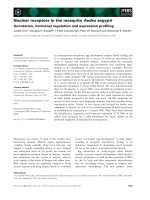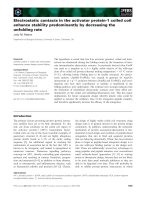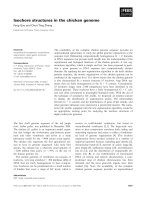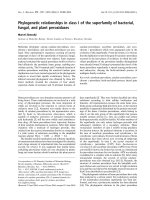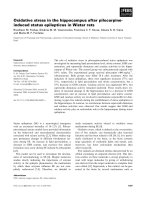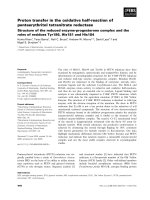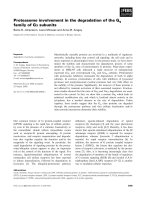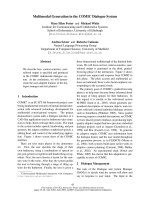Báo cáo khoa học: Conserved residues in the N-domain of the AAA+ chaperone ClpA regulate substrate recognition and unfolding pdf
Bạn đang xem bản rút gọn của tài liệu. Xem và tải ngay bản đầy đủ của tài liệu tại đây (899.05 KB, 11 trang )
Conserved residues in the N-domain of the AAA+
chaperone ClpA regulate substrate recognition and
unfolding
Annette H. Erbse
1,
*, Judith N. Wagner
1,
*, Kaye N. Truscott
2
, Sukhdeep K. Spall
2
, Janine Kirstein
1,3
,
Kornelius Zeth
4
,Ku
¨
rsad Turgay
1,3
, Axel Mogk
1
, Bernd Bukau
1
and David A. Dougan
1,2
1 Zentrum fu
¨
r Molekulare Biologie Heidelberg, Universita
¨
t Heidelberg, Heidelberg, Germany
2 Department of Biochemistry, La Trobe University, Melbourne, Australia
3 Institut fu
¨
r Biologie, Freie Universita
¨
t Berlin, Berlin, Germany
4 MPI fu
¨
r Entwicklungsbiologie, Tubingen, Germany
The AAA+ superfamily [1] is an extensive group of
proteins involved in a broad range of biological func-
tions. Its members are present in all kingdoms of life
and often play a crucial role in cell maintenance. In
bacteria, several AAA+ proteins (e.g. ClpA, ClpB,
ClpX, HslU and Lon) are central to the protein qual-
ity-control network [2]. They employ a common mech-
anism, involving the binding and hydrolysis of ATP,
to mediate the unfolding ⁄ disassembly of a variety of
proteins, including large macromolecular complexes
[3]. Although several of these proteins share consider-
able sequence similarity, they demonstrate distinct
substrate specificity. For example, in Escherichia coli,
ClpA is responsible, either directly or indirectly via the
adaptor protein ClpS, for recognition of substrates
such as SsrA-tagged proteins or N-end rule substrates
Keywords
AAA+; binding; ClpA; SsrA; unfolding
Correspondence
D. A. Dougan, Department of Biochemistry,
La Trobe University, Melbourne 3086,
Australia
Fax: +61 3 9479 2467
Tel: +61 3 9479 3276
E-mail:
B. Bukau, Zentrum fu
¨
r Molekulare Biologie
Heidelberg, Universita
¨
t Heidelberg, INF 282,
Heidelberg D-69120, Germany
Fax: +49 6221 54 5894
Tel: +49 6221 54 6795
E-mail:
*These authors contributed equally to this
work
(Received 22 November 2007, revised 10
January 2008, accepted 14 January 2008)
doi:10.1111/j.1742-4658.2008.06304.x
Protein degradation in the cytosol of Escherichia coli is carried out by a
variety of different proteolytic machines, including ClpAP. The ClpA com-
ponent is a hexameric AAA+ (ATPase associated with various cellular
activities) chaperone that utilizes the energy of ATP to control substrate
recognition and unfolding. The precise role of the N-domains of ClpA in
this process, however, remains elusive. Here, we have analysed the role of
five highly conserved basic residues in the N-domain of ClpA by monitor-
ing the binding, unfolding and degradation of several different substrates,
including short unstructured peptides, tagged and untagged proteins. Inter-
estingly, mutation of three of these basic residues within the N-domain of
ClpA (H94, R86 and R100) did not alter substrate degradation. In contrast
mutation of two conserved arginine residues (R90 and R131), flanking a
putative peptide-binding groove within the N-domain of ClpA, specifically
compromised the ability of ClpA to unfold and degrade selected substrates
but did not prevent substrate recognition, ClpS-mediated substrate delivery
or ClpP binding. In contrast, a highly conserved tyrosine residue lining the
central pore of the ClpA hexamer was essential for the degradation of all
substrate types analysed, including both folded and unstructured proteins.
Taken together, these data suggest that ClpA utilizes two structural ele-
ments, one in the N-domain and the other in the pore of the hexamer, both
of which are required for efficient unfolding of some protein substrates.
Abbreviations
AAA+, ATPase associated with various cellular activities; FITC, fluorescein isothiocyanate; GFP, green fluorescent protein; kR, lambda
repressor.
1400 FEBS Journal 275 (2008) 1400–1410 ª 2008 The Authors Journal compilation ª 2008 FEBS
[4,5]. Once recognized, these substrates are unfolded
by the AAA+ protein, in an ATP-dependent manner,
and translocated through the central pore of the oligo-
mer into the associated ClpP peptidase, where they are
degraded into short peptides.
AAA+ proteins usually contain an N-terminal
domain (N-domain) that serves as a docking site for
various adaptor proteins [6–10]. ClpA consists of three
domains: an N-domain and two ATP-binding domains
referred to as the D1 and D2 domains. Interestingly,
deletion of the N-domain from ClpA not only abol-
ishes binding of the adaptor protein, ClpS, but addi-
tionally modulates ClpA substrate specificity [8,11–13].
This change in substrate specificity is poorly under-
stood, and the mechanism by which the N-domains
might regulate ClpA function is controversial, although
it has been proposed that the N-domain controls bind-
ing of ClpA to ClpP [14]. Interestingly, there is also
considerable debate regarding the role of the ClpB
N-domain (which shares a common fold with the
N-domain of ClpA) in substrate selection [15–17]. One
difficulty in understanding the role of the N-domain of
ClpA stems from the variety of activities exhibited by
various DNClpA constructs tested, each containing
different lengths of ‘linker’ residues that connect the
N-domain to the D1 domain. In order to avoid the
potential problems associated with ‘ragged’ ends of
DNClpA, we chose to create several single and double
point mutations within the N-domain to probe
N-domain function.
Here, using mutational analysis, we report the iden-
tification of a structural element composed of con-
served basic amino acids (R90 and R131), located
within the N-domain of ClpA, that dramatically alters
the ability of ClpA to degrade selected substrates. This
element, although dispensable for the recognition of
the SsrA tag per se, modulates the binding, unfolding
and subsequent degradation of SsrA-tagged protein
substrates. We propose that this element plays an
important role in the binding and subsequent release
of substrates, by triggering ‘local’ unfolding of the sub-
strate. We speculate that the ATP-dependent global
unfolding of some protein substrates is initiated
through productive binding to the substrate via two
elements in ClpA, one in the N-domain and the other
in the pore of the ClpA hexamer. In the case of short
unstructured peptides or unfolded proteins such as
casein, binding to the tyrosine residues in the hexamer-
ic pore of ClpA is sufficient for substrate translocation
to occur; however, in other cases such as SsrA-tagged
protein substrates, binding at both sites is required for
translocation-mediated global unfolding to proceed
efficiently.
Results
Two conserved arginine residues (R90 and R131)
within the N-domain are required for full ClpA
function
We were interested to understand how substrates are
recognized and subsequently unfolded by ClpA. As
mutation of the tyrosine residue located in the pore
has been demonstrated to inhibit degradation of all
substrates tested [18], we postulated that substrate dis-
crimination must arise from an alternative region
within ClpA. Based on previous findings showing that
deletion of the N-domain of ClpA dramatically
reduced the rate of degradation of GFP–ssrA and to a
lesser extent casein [8,11], we speculated that the
N-domain facilitates an early binding step, contribut-
ing to specific recognition of substrates such as SsrA-
tagged proteins. In order to further study the role of
the N-domains in substrate recognition, we compared
the amino acid sequences of this region in several
AAA+ proteins (Fig. 1). From this analysis, we noted
a high occurrence of conserved basic residues distrib-
uted throughout the domain, several of which (R86,
R90, H94, R100 and R131) flanked a hydrophobic
groove (Fig. 2A). To test the role of these basic resi-
dues, we constructed a number of single (R86A, R90A
and R131A) and double (H94A ⁄ R100A and
R90A ⁄ R131A) point mutations in the N-domain of
ClpA (Fig. 2A).
First, we compared the degradation of SsrA-tagged
GFP by wild-type and mutant ClpAP complexes
(Fig. 2B). The ClpP-dependent degradation of GFP–
ssrA mediated by either the single mutant R86A
(Fig. 2B, open inverted triangles) or the double mutant
H94A ⁄ R100A (Fig. 2B, filled diamonds) was unaf-
fected. In contrast the rate of ClpP-mediated degrada-
tion by the single mutants R90A (Fig. 2B, open
diamonds) and R131A (Fig. 2B, open triangles) was
reduced approximately threefold when compared to
wild-type ClpA (Fig. 2B, open circles). Interestingly,
when we combined these two single point mutants to
create the double mutant R90A ⁄ R131A (herein referred
to as RR ⁄ AA), the degradation of GFP–ssrA was
reduced dramatically (Fig. 2B, filled circles). Although
these mutant proteins exhibited different abilities with
regard to mediation of GFP–ssrA degradation
(Fig. 2B), the basal ATPase activity was not affected
(Fig. 3E, compare lanes 1 and 4). Given that the
ATPase activity of ClpA is dependent on its oligomeri-
zation [19], as the nucleotide is bound between two
adjacent subunits, this result suggests that the overall
hexameric structure of RR ⁄ AA was maintained.
A. H. Erbse et al. Substrate recognition and unfolding by ClpA
FEBS Journal 275 (2008) 1400–1410 ª 2008 The Authors Journal compilation ª 2008 FEBS 1401
To determine whether this dramatic change in ClpP-
mediated degradation of GFP–ssrA by RR ⁄ AA was
simply due to an inability to bind ClpP, we performed
co-immunoprecipitation experiments using a-ClpP anti-
serum (Fig. 2C). The co-immunoprecipitation of ClpA
with the a-ClpP antiserum was specific, as recovery of
ClpA required the addition of both ATPcS (a non-
hydrolysable analogue of ATP) and ClpP (Fig. 2C,
lane 3). Importantly, RR ⁄ AA (Fig. 2C, lane 4) did not
show any change in ClpP interaction when compared to
wild-type ClpA (Fig. 2C, lane 3), as determined by
quantification of ClpA amounts after co-immunopre-
cipitation (Fig. 2C, lower panel), suggesting that the
overall structure of the RR ⁄ AA mutant is not compro-
mised. Likewise, the other N-domain mutants tested
(i.e. R86A and H94A ⁄ R100A) also exhibited wild-type
ClpA behaviour (data not shown).
An alternative explanation for the lack of GFP–ssrA
degradation exhibited by RR ⁄ AA could be that the
N-domain was structurally compromised as a result of
mutations in this region. To confirm that neither the
N-domain structure nor the overall structure of these
mutant proteins were adversely affected, we tested the
degradation of a model N-end rule substrate, FR-lin-
ker–GFP [20]. The ClpP-mediated degradation of this
substrate class requires specific interaction between
ClpS and the N-domain of ClpA. Consequently, dra-
matic changes to the structure of the N-domain of
ClpA would inhibit ClpS binding and thereby ClpS-
dependent degradation of this substrate. As expected,
the ClpP-mediated degradation of FR-linker–GFP
by wild-type ClpA required the addition of ClpS
(Fig. 2D). Importantly, like wild-type ClpA, RR ⁄ AA
was also able to support the ClpS-dependent degrad-
ation of FR-linker–GFP (Fig. 2D), demonstrating a
functional interaction between ClpS and the N-domain
of RR ⁄ AA, and this result suggests that neither the
local nor the overall structure of the RR ⁄ AA mutant
was compromised.
Mutation of the conserved arginine residues has
only a moderate effect on degradation of short
unstructured peptides and the model unfolded
protein, casein
To determine whether RR ⁄ AA also demonstrated an
inability to degrade other known ClpAP substrates, we
examined the ClpP-dependent degradation of several
model ClpA substrates, including the N-terminal
domain of the k repressor fused to the SsrA tag (kR–
ssrA) [21], two short peptides, and the model unfolded
protein a-casein [22]. As for GFP–ssrA, the rate of
fluorescein-labelled kR–ssrA degradation mediated by
RR ⁄ AA was dramatically reduced when compared to
wild-type ClpA (Fig. 3A, filled circles and open
circles). Interestingly, the rate of RR ⁄ AA-mediated
degradation was not significantly altered for an SsrA-
tagged peptide (Fig. 3B), indicating that recognition of
the SsrA tag is not affected by RR ⁄ AA. Moreover,
two other unfolded substrates, a-casein (Fig. 3C) and
a 21-amino-acid polypeptide derived from r
32
(a
loosely folded protein) [23] (Fig. 3D), were also
degraded by RR ⁄ AA with similar kinetics to wild-type
ClpA, in a ClpP-dependent manner. In contrast to the
Fig. 1. Multiple sequence alignment of the N-domain of bacterial ClpA homologues and E. coli ClpB. Amino acid sequences of the N-domain
of ClpA from E. coli (P0ABH9), V. cholera (Q9KSW2), P. aeruginosa (Q9I0L8), X. fastidosa (Q87DL7), B. japonicum (Q89JW6), C. crescentus
(Q9A5H9), N. meningitidis (Q9JZZ6), D. radiodurans (Q9RWS7), C. acetobutylicum (Q97I30) and H. pylori (O24875) were aligned together
with the amino acid sequence of the N-domain of E. coli ClpB (P63284). Conserved hydrophobic residues are highlighted in grey, conserved
basic residues are highlighted in blue, and conserved acidic residues are highlighted in red. Amino acid numbering corresponds to the ClpA
sequence from E. coli. Residues chosen for mutation are indicated by asterisks.
Substrate recognition and unfolding by ClpA A. H. Erbse et al.
1402 FEBS Journal 275 (2008) 1400–1410 ª 2008 The Authors Journal compilation ª 2008 FEBS
substrate-dependent degradation exhibited by RR ⁄ AA,
the ClpA pore mutant (Y259A), which is unable to
translocate GFP–ssrA [18], prevented the degradation
of both kR–ssrA (Fig. 3A, open diamonds) and fluo-
rescein isothiocyanate-labelled casein (FITC-casein;
data not shown). Consistent with these results, casein
stimulated the ATPase activity of both wild-type ClpA
and RR ⁄ AA (Fig. 3E), while, in contrast, SsrA-tagged
GFP only stimulated the ATPase activity of wild-type
ClpA (Fig. 3E). Together, these data suggest that
RR ⁄ AA has a reduced ability to initiate unfolding of
more tightly folded proteins, but retains full ability to
translocate short unstructured peptides and model
unfolded proteins into the ClpP chamber for degrada-
tion.
RR ⁄ AA delays the release and subsequent
unfolding of certain protein substrates
Before testing the unfolding activity of RR ⁄ AA, we
wished to compare the ability of the RR ⁄ AA mutant
to bind to the various substrates tested. To do this, we
constructed a ClpA variant in which the glutamic acid
residue within the Walker B motif of each AAA
domain (E286, E565) was changed to alanine. This
double Walker B mutant (herein referred to as dWB)
Fig. 2. Two conserved arginine residues flanking a hydrophobic groove are essential for N-domain function. (A) Structure of the ClpA N-
domain. ClpA is shown as a ribbon diagram (dark grey), and the side chains of R86, R90, H94, R100 and R131 are represented as a ball and
stick (blue) flanking the putative peptide-binding groove (orange). The surface of the N-domain is shaded light grey, and R86, R90, H94,
R100 and R131 are highlighted in blue. (B) The ClpP-mediated degradation of GFP–ssrA was monitored by fluorescence in the presence of
wild-type ClpA (open circles), R86A (inverted open triangles), H94A ⁄ R100A (filled diamonds), R90A (open diamonds), R131A (open triangles)
and RR ⁄ AA (filled circles). (C) The interaction between wild-type ClpA (lane 3) or RR ⁄ AA (lane 4) with ClpP, assessed by co-immunoprecipita-
tion using a-ClpP antiserum, was visualized by staining of the protein bands using Coomassie brilliant blue following separation by SDS–
PAGE. In the absence of added ATPcS (lane 1) or ClpP (lane 2), ClpA was not co-precipitated. The relative amount of ClpA binding to ClpP
was determined from quantification of three independent experiments. Error bars represent the standard error of the mean. A non-specific
protein band is indicated by an asterisk. (D) The functional interaction between ClpS and ClpA (wild-type and RR ⁄ AA) was observed by moni-
toring the ClpS-dependent degradation of FR-linker–GFP (in the presence of ClpP).
A. H. Erbse et al. Substrate recognition and unfolding by ClpA
FEBS Journal 275 (2008) 1400–1410 ª 2008 The Authors Journal compilation ª 2008 FEBS 1403
and the corresponding mutant in RR⁄ AA (referred to
as RR ⁄ dWB) were used to monitor substrate binding
as determined by co-elution of substrate–ClpA
complexes during gel filtration. Initially, we tested the
ability of dWB and RR ⁄ dWB to interact with FITC-
casein. As a control, in the absence of ClpA,
FITC-casein eluted in a single peak at 21.5 mL
(Fig. 4A, open circles). However, upon addition of
ATP and dWB (Fig. 4A, open triangles) or RR ⁄ dWB
(Fig. 4A, filled diamonds), the FITC-casein peak
shifted and formed two new peaks, the largest of
which co-eluted with the ClpA hexamer (Fig. 4A, grey
block). Quantification of this peak indicated that
approximately 30 and 40 pmol of FITC-casein were
bound to the hexamers of dWB and RR ⁄ dWB respec-
tively. Next we compared the ability of kR–ssrA
(Fig. 4B) and GFP–ssrA (Fig. 4C) to bind to dWB or
RR ⁄ dWB. As controls, each substrate (in the absence
of ClpA) was also separated by gel filtration and the
amount of substrate was quantified in the hexamer
region of the gel filtration profile (Fig. 4B,C, lane 1).
Similarly, as a further control, each substrate in the
presence of dWB (Fig. 4B,C, lane 2) or RR ⁄ dWB
(Fig. 4B,C, lane 4) was also quantified after separation
by gel filtration in the absence of ATP. These controls
demonstrated a strict requirement for ATP in the
interaction between dWB ClpA and each substrate
tested. Interestingly, under the same conditions,
although very little change in the binding of FITC-
casein was observed, approximately threefold more
Fig. 3. RR ⁄ AA exhibits different abilities with regard to degradation of various ClpA substrates. (A) ClpP-mediated degradation of fluores-
cein-labelled kR–ssrA by ClpA (open circles), RR ⁄ AA (closed circles) and Y259A (open diamonds) was monitored by an increase in fluores-
cence (excitation at 490 nm and emission at 520 nm). (B) ClpP-mediated degradation of a SsrA tagged peptide (50 l
M) was monitored in
the absence of ClpA (ClpP) and the presence of wild-type (ClpA) or mutant (RR ⁄ AA) proteins. (C) Time course of a-casein degradation by
ClpA or RR ⁄ AA in the presence of ClpP. (D) ClpP-mediated degradation of a short unstructured peptide derived from r
32
(QRKLFFNLEKTKQRLGWFNQC) by RR ⁄ AA is not compromised. ClpP-mediated degradation of the peptide (50 lM) was monitored over time
in the presence of wild-type ClpA (open circles) or RR ⁄ AA (filled circles). The amount of peptide remaining was determined by quantification
of the Coomassie-stained band following separation of the proteins by Tris ⁄ Tricine SDS–PAGE. (E) The ATPase activity of wild-type ClpA
(lanes 1–3), RR ⁄ AA (lanes 4–6) and Y259A (lanes 7–9) was determined either in the absence of substrate (white bars; lanes 1, 4 and 7,
respectively) or in the presence of GFP–ssrA (grey bars; lanes 2, 5 and 8, respectively) or a-casein (black bars; lanes 3, 6 and 9, respec-
tively). The ATPase activity (relative to ClpA in the absence of substrate) was determined from three independent experiments. Error bars
represent the standard error of the mean.
Substrate recognition and unfolding by ClpA A. H. Erbse et al.
1404 FEBS Journal 275 (2008) 1400–1410 ª 2008 The Authors Journal compilation ª 2008 FEBS
SsrA-tagged substrate co-eluted with RR ⁄ dWB when
compared to dWB ClpA (Fig. 4B,C). These data are
consistent with the notion that RR ⁄ AA is able to bind
each substrate but exhibits a change in the release of
some substrates (e.g. kR–ssrA). This lack of release is
expected to hinder unfolding and ultimately reduce
degradation of the substrate.
To further test the possibility that RR ⁄ AA has a
compromised unfolding activity, we compared the abil-
ity of wild-type ClpA and RR ⁄ AA to unfold SsrA-
tagged GFP in the presence of the GroEL trap [24].
As expected wild-type ClpA, in the absence of ClpP,
was able to unfold GFP–ssrA (Fig. 5A, open circles)
but the unfolding ability of RR ⁄ AA (Fig. 5A, filled
circles) was strongly compromised. Surprisingly, the
kinetics of unfolding by RR ⁄ AA measured using the
GroEL trap were slower than expected. As this
method does not directly measure the change in sub-
strate conformation and may be affected by rapid
refolding of the substrate, we chose to validate this
finding using a more sensitive and direct approach.
Thus, hydrogen–deuterium exchange was used to mea-
sure the unfolding of GFP–ssrA in the presence and
absence of either wild-type ClpA or RR⁄ AA. Follow-
ing incubation of GFP–ssrA (28 954 Da) in deuterated
buffer, the mass of GFP–ssrA rapidly increased to
29 034 Da within the first 5 min of the experiment.
This change in mass occurred in the absence (data not
shown) and the presence of wild-type or mutant ClpA
(indicated by the hash symbol, #, in Fig. 5B,C), and
resulted from the rapid exchange of 80 accessible
amide protons. In the absence of ClpA, the remaining
amide protons within the protected core did not
exchange over a period of 2 h (data not shown). In the
Fig. 4. Mutations in the N-domain do not prevent substrate interaction. (A) FITC-casein (500 pmol) was separated by gel filtration in the
presence of 2 m
M ATP (open circles), 160 pmol dWB ClpA
6
plus 2 mM ATP (open triangles) or 160 pmol RR ⁄ dWB ClpA
6
plus 2 mM ATP
(filled diamonds) as described in Experimental procedures. The molecular mass standards thyroglobulin (669 kDa), ferritin (440 kDa), aldolase
(232 kDa) and ovalbumin (43 kDa) eluted as indicated by the arrows labelled 669, 440, 232 and 43 respectively. The position at which ClpA
6
eluted is indicated with an arrow labelled ClpA
6
. The amount of casein bound was calculated from the peak elution (boxed in grey) that co-
eluted with ClpA
6
. (B) Fluorescein-labelled kR–ssrA (450 pmol) was separated by gel filtration without the addition of ATP (white bar, lane 1),
in the presence of 160 pmol dWB ClpA
6
without (lane 2) or with addition of 2 mM ATP (lane 3), or in the presence of 160 pmol RR ⁄ dWB
ClpA
6
without (lane 4) or with addition of 2 mM ATP (lane 5) as described in (A). (C) GFP–ssrA (990 pmol) was separated by gel filtration
without the addition of ATP (lane 1), in the presence of 160 pmol dWB ClpA
6
without (lane 2) or with addition of 2 mM ATP (lane 3), or in
the presence of 160 pmol RR ⁄ dWB ClpA
6
without (lane 4) or with addition of 2 mM ATP (lane 5) as described in (A).
A. H. Erbse et al. Substrate recognition and unfolding by ClpA
FEBS Journal 275 (2008) 1400–1410 ª 2008 The Authors Journal compilation ª 2008 FEBS 1405
presence of ClpA and ATP, we observed a further
peak (Fig. 5B, asterisk), which arises from incorpora-
tion of deuterium into the core region of GFP–ssrA as
a result of its unfolding. With time, the relative
amount of this heavier species (29 130 Da) increased,
reflecting complete unfolding of all GFP–ssrA by ClpA
(Fig. 5D, open circles). In contrast, the rate of
RR ⁄ AA-mediated unfolding (Fig. 5D, filled circles)
was significantly slower than that of wild-type ClpA,
with more than half of the GFP–ssrA still folded after
30 min (Fig. 5C, asterisk). Taken together, these data
suggest that the change in degradation of GFP–ssrA
mediated by RR⁄ AA stems from a delayed release of
substrate, which results in reduced unfolding of the
substrate.
Discussion
As for most AAA+ proteases, ClpA utilizes the
hydrolysis of ATP to drive substrate unfolding and
translocation into the associated peptidase (ClpP). To
date, however, the role of the N-domains in this pro-
cess has not been well defined as several conflicting
roles have been proposed. Despite this, one aspect of
the N-domain function is unambiguous – it is essential
for ClpS binding and hence the delivery of N-end rule
substrates to ClpAP. Currently, much of our mecha-
nistic understanding of the ClpAP machine is based
largely on the use of model proteins such as casein and
GFP–ssrA. Previous studies have demonstrated that a
ring of tyrosine residues located in the pore of the
ClpA hexamer is essential for the translocation and
degradation of all substrates [18]. In contrast, various
N-domain deletions of ClpA have exhibited differing
affects on substrate degradation [8,11,12], which may
simply result from reduced ClpP interaction [14]. In
order to better understand N-domain function, we
analysed in detail both the sequence and three-dimen-
sional structure of the ClpA N-domain [25].
In this study, we have identified an element within
the N-domain of ClpA (composed of two conserved
basic residues, R90 and R131) that flanks a hydropho-
bic groove. This element, via an unknown mechanism,
contributes to the dynamic nature of substrate inter-
action with ClpA. In contrast to mutation of the
hexameric pore tyrosine residue (which abolishes
degradation of all substrates examined), the RR ⁄ AA
mutant alters the unfolding of certain substrate types.
For example, SsrA-tagged proteins are bound by
RR ⁄ AA but release of the substrate is inhibited
(Fig. 4). This slow substrate release appears to be spe-
cific for SsrA-tagged proteins and was not observed
for the model unfolded protein casein or short peptide
substrates (including an SsrA-tagged peptide) as deter-
mined by rapid degradation of these peptides
(Fig. 3B,D). RR ⁄ AA also exhibited a reduced rate of
GFP–ssrA unfolding as measured by hydrogen–deute-
rium exchange or in the presence of the GroEL trap
(Fig. 5). Collectively, these data confirm that the SsrA
tag does not bind to the N-domain of ClpA, and sug-
gest that these basic residues influence substrate release
from the N-domain, which in turn allows substrate
unfolding to proceed.
Importantly, in contrast to previous studies on the
N-domain of ClpA (which examined the effect of
removing the entire domain and resulted in dramatic
affects on ATPase activity or ClpP binding [14,26]),
our site-directed mutagenesis approach has allowed us
Fig. 5. Mutations in the N-domain reduce
substrate unfolding. Unfolding of GFP–ssrA
was monitored (A) in the presence of the
GroEL trap D87K upon the addition of ClpA
(open circles) or RR ⁄ AA (closed circles), (B)
by hydrogen–deuterium exchange in D
2
O
buffer in the presence of ClpA and ATP, or
(C) by hydrogen–deuterium exchange in
D
2
O buffer in the presence of RR ⁄ AA and
ATP. (D) The relative amount of ‘unfolded’
GFP–ssrA (29 130 Da) was determined in
the presence of wild-type ClpA (open
circles) or RR ⁄ AA (filled circles).
Substrate recognition and unfolding by ClpA A. H. Erbse et al.
1406 FEBS Journal 275 (2008) 1400–1410 ª 2008 The Authors Journal compilation ª 2008 FEBS
to specifically probe N-domain function. The RR ⁄ AA
mutant not only displays normal basal ATPase activity
but also retains the ability to interact with both ClpS
and ClpP and most importantly is able to translocate
short peptides and unfolded protein substrates into the
ClpP chamber for degradation. Despite these normal
activities, RR ⁄ AA shows a dramatic decrease in the
ability to degrade SsrA-tagged proteins (Figs 2 and 3).
Nevertheless, this defect does not result from a simple
inability to interact with the SsrA tag (as demonstrated
by efficient degradation of the SsrA peptide by
RR ⁄ AA and stable binding of two SsrA-tagged pro-
teins to RR⁄ dWB). In contrast, this region appears to
be involved in a more general binding task, which is
consistent with previous findings [18,27], and moreover
may modulate the ability of ClpA to bind, unfold and
ultimately degrade substrates such as GFP–ssrA.
Interestingly, ClpS was observed to interact directly
with R131 in a ClpS–ClpA complex [28]. However,
this interaction is not required for ClpS-mediated
action [25], and hence most likely mimics a substrate
interaction, suggesting that R131 may interact directly
with some substrates. Nevertheless, using an in vitro
crosslinking approach [29], which permits the detection
of dynamic interactions, we did not observe an inter-
action between various N-domain residues (His94,
Leu109 and Val134) located in close proximity to R90
and R131 and a substrate (data not shown). Impor-
tantly, these variants were able to crosslink to ClpS
and mediated the degradation of GFP–ssrA and FR-
linker–GFP by ClpP (data not shown). Thus it remains
unclear whether these arginine residues are directly
involved in substrate binding. Of note, although the
N-domains of ClpA and p97 are not structurally
related, mutations in several basic residues (R95G,
R155C, R155H) within the N-domain of p97 have
been implicated in the inclusion body myopathy asso-
ciated with Paget’s disease of bone and fronto-tempo-
ral dementia [30]. Interestingly, in the crystal structure
of p97, these basic residues are not surface-exposed
but face the AAA domain, in close proximity to the
Walker A motif. Hence, it is appealing to speculate
that the arginine residues in ClpA do not regulate sub-
strate unfolding directly through interaction with the
substrate, but instead coordinate substrate bind-
ing ⁄ release via an interaction elsewhere in ClpA. Inter-
estingly, although RR ⁄ AA has a dramatic inhibitory
effect on the degradation of SsrA-tagged GFP, it does
not affect binding or delivery of the model N-end rule
substrate (FR-linker–GFP) by ClpS (Fig. 2), which
suggests one of two possibilities. Firstly, that the defect
in RR ⁄ AA-mediated unfolding is not dependent on
the global thermodynamic stability of the substrate,
but rather correlates with local unfolding of the sub-
strate (i.e. unfolding of the N- or C-terminus). This
can be understood by examining the N- and C-termi-
nal structures of GFP. The first 11 N-terminal residues
of GFP form an a-helix, which leads into a parallel
b-sheet. In contrast, the last 12 amino acids of GFP
form a b-strand leading into an anti-parallel b-sheet
[31]. In the case of GFP–ssrA, release of this substrate
from ClpA may be more effective than from RR ⁄ AA,
allowing ClpA to perform the ATP-dependent unfold-
ing step more efficiently. Interestingly, it has been pro-
posed [32,33] that an a-helix is more easily unfolded
than a b-sheet. Therefore, these data support the idea
that RR ⁄ AA has reduced ability to trigger local
unfolding of a substrate (at the N- or C-terminus) and
are consistent with the idea that local unfolding by the
N-domain may be required before global unfolding of
the substrate can proceed, as has been suggested for
the AAA+ protein PAN [34]. Alternatively, different
ClpA substrates may utilize various recogni-
tion ⁄ unfolding pathways – some that require these
arginine residues in the N-domain (e.g. GFP–ssrA)
and other that do not (e.g. N-end rule substrates,
delivered by ClpS). Therefore, ClpS-delivered sub-
strates may bypass the need for these residues in the
N-domain. In this case, it is appealing to speculate
that ClpS itself may act as the second binding site
required for unfolding, thereby replacing a need for
the N-domain.
Experimental procedures
Proteins
ClpA, ClpP and GFP–ssrA were over-expressed from an
isopropyl thio-b-d-galactoside-inducible plasmid and puri-
fied from the clarified lysates as described previously [8].
All ClpA mutant proteins were purified as for wild-type
ClpA. kR–ssrA was labelled with fluorescein as described
previously [21]. Purification of FR-linker–GFP was per-
formed as previously described [20]. FITC-casein was
obtained from Sigma (St Louis, MO, USA). All proteins
were > 95% pure as determined by Coomassie-stained
SDS–PAGE. Protein concentrations were determined using
a Bradford assay system (Bio-Rad, Munich, Germany)
using BSA purchased from Pierce (Rockford, IL, USA) as
a standard, and refer to the protomer.
Unfolding and protein degradation assays
GFP–ssrA degradation was monitored by changes in
fluorescence (excitation at 400 nm and emission at
510 nm). Degradation of fluorescein-labelled kR–ssrA and
A. H. Erbse et al. Substrate recognition and unfolding by ClpA
FEBS Journal 275 (2008) 1400–1410 ª 2008 The Authors Journal compilation ª 2008 FEBS 1407
FITC-labelled a-casein was monitored by changes in fluo-
rescence (excitation at 490 nm and emission at 520 nm)
using a Perkin-Elmer fluorescence spectrometer LS50B
(Waltham, MA, USA). The reactions were carried out as
described previously [24]. Unfolding assays for GFP–ssrA
were performed in the presence of GroEL trap D87K as
previously described [24]. Non-fluorescent degradation
assays (GFP–ssrA, a-casein, FR-linker–GFP and peptides)
were preformed as previously described [8,20]. Unless other-
wise stated, 1 lm ClpA (wild-type and all mutant ClpA
proteins) and 1 lm ClpP were used. Samples were removed
from the reactions at the indicated time points and degra-
dation was stopped by the addition of sample buffer. Pro-
tein substrates were separated by 15% SDS–PAGE and
peptide substrates by 16.5% Tris ⁄ Tricine SDS–PAGE.
Proteins were visualized by Coomassie brilliant blue stain-
ing. When required, protein bands were quantified using
geleval1.21 (FrogDance Software, Dundee, UK).
Analysis of ClpA–ClpP complexes by
co-immunoprecipitation
To assess ClpA–ClpP complex formation, wild-type or
mutant ClpA (1 lm) and ATPcS(2mm ) were preincubated
in co-immunoprecipitation buffer (50 mm Tris ⁄ HCl pH 7.5,
300 mm NaCl, 40 mm Mg-acetate, 10% glycerol) at room
temperature for 2 min prior to the addition of ClpP (1 lm).
After a further 3 min incubation at room temperature, the
protein samples were mixed by end-over-end rotation for
1 h at 4 °C with Protein A–Sepharose obtained from Sigma
(St Louis, MO, USA) containing pre-bound antibodies
against E. coli ClpP. Following removal of the unbound
fraction, the Protein A–Sepharose beads were washed three
times with ice-cold co-immunoprecipitation buffer contain-
ing 10 mm ATP, then bound proteins were eluted with
50 mm glycine, pH 2.5. Proteins were separated by 10%
SDS–PAGE and detected by Coomassie brilliant blue
staining.
Gel filtration and substrate binding
Gel filtration was carried out at 4 °C using a Superose 6
column (GE Healthcare, Uppsala, Sweden) in buffer con-
taining 20 mm Tris ⁄ HCl pH 7.4, 100 mm KCl, 40 mm
NaCl, 10 mm MgCl
2
,5mm dithiothreitol, 0.1 mm EDTA,
5% glycerol with or without 2 mm ATP. Fractions of
250 lL were collected in a 96-well plate and samples analy-
sed by fluorescence and 15% SDS–PAGE.
ATPase assay
The ATPase activity of wild-type and mutant ClpA
(0.5 lm) was measured at 660 nm, in degradation buffer
(25 mm Tris ⁄ HCl pH 7.5, 100 mm NaCl, 100 mm KCl,
20 mm MgCl
2
, 0.05% Triton X-100, 10% glycerol) in the
absence or presence of unlabelled substrate (5 lm). The
reaction was started by the addition of 2 mm ATP and
stopped by the addition of 800 lL malachite green solution
(0.034% malachite green, 0.1% Triton X-100 and
10.5 gÆ L
)1
ammonium molybdate in 1 N HCl) and 100 lL
of 34% citrate.
Hydrogen–deuterium exchange and mass
spectrometry
GFP–ssrA (2 lm) was diluted 75· into deuterated buffer
(50 mm Tris ⁄ HCl pH 7.5, 300 mm NaCl, 10% glycerol,
0.5 mm dithiothreitol, 10 mm ATP). Where appropriate,
ClpA or RR ⁄ AA (2 lm) was added at the start of the
exchange reaction (t = 0 min); for the control experiment,
equal volumes of non-deuterated buffer were added. At
indicated time points, samples were removed from the reac-
tion. The hydrogen–deuterium exchange was stopped by
rapidly lowering the pH to 2.4 at 4 °C. All subsequent steps
were carried out on ice to minimize back exchange. The pro-
teins were separated on a micro-C4RP column connected to
an ESI-QTOF mass spectrometer (Applied Biosystems,
Foster City, CA, USA) using an acetonitrile gradient.
Acknowledgements
We thank E. Weber-Ban (Eidgeno
¨
ssiche Technische
Hochschule Zurich) for providing fluorescently labelled
kR–ssrA. This research was supported by the Austra-
lian Research Council Discovery Project scheme
(DP0450051), the Deutsche Forschungsgemeinschaft
priority program ‘Proteolysis in Prokaryotes: Protein
Quality Control and Regulatory Principles’ and Aus-
tralian Research Council QEII Fellowships to D.A.D
and K.N.T.
References
1 Neuwald AF, Aravind L, Spouge JL & Koonin EV
(1999) AAA+: a class of chaperone-like ATPases asso-
ciated with the assembly, operation, and disassembly of
protein complexes. Genome Res 9, 27–43.
2 Dougan DA, Mogk A & Bukau B (2002) Protein fold-
ing and degradation in bacteria: to degrade or not to
degrade? That is the question. Cell Mol Life Sci 59 ,
1607–1616.
3 Ogura T & Wilkinson AJ (2001) AAA+ superfamily
ATPases: common structure – diverse function. Genes
Cells 6, 575–597.
4 Mogk A, Schmidt R & Bukau B (2007) The N-end rule
pathway for regulated proteolysis: prokaryotic and
eukaryotic strategies. Trends Cell Biol 17, 165–172.
Substrate recognition and unfolding by ClpA A. H. Erbse et al.
1408 FEBS Journal 275 (2008) 1400–1410 ª 2008 The Authors Journal compilation ª 2008 FEBS
5 Varshavsky A (1996) The N-end rule: functions, myster-
ies, uses. Proc Natl Acad Sci USA 93, 12142–12149.
6 Meyer HH, Shorter JG, Seemann J, Pappin D & War-
ren G (2000) A complex of mammalian ufd1 and npl4
links the AAA-ATPase, p97, to ubiquitin and nuclear
transport pathways. EMBO J 19, 2181–2192.
7 Rouiller I, Butel VM, Latterich M, Milligan RA &
Wilson-Kubalek EM (2000) A major conformational
change in p97 AAA ATPase upon ATP binding. Mol
Cell 6, 1485–1490.
8 Dougan DA, Reid BG, Horwich AL & Bukau B (2002)
ClpS, a substrate modulator of the ClpAP machine.
Mol Cell 9, 673–683.
9 Dougan DA, Mogk A, Zeth K, Turgay K & Bukau B
(2002) AAA+ proteins and substrate recognition, it all
depends on their partner in crime. FEBS Lett 529,6–
10.
10 Dougan DA, Weber-Ban E & Bukau B (2003) Targeted
delivery of an ssrA-tagged substrate by the adaptor pro-
tein SspB to its cognate AAA+ protein ClpX. Mol Cell
12, 373–380.
11 Lo JH, Baker TA & Sauer RT (2001) Characterization
of the N-terminal repeat domain of Escherichia coli
ClpA-A class I Clp ⁄ HSP100 ATPase. Protein Sci 10,
551–559.
12 Singh SK, Rozycki J, Ortega J, Ishikawa T, Lo J, Ste-
ven AC & Maurizi MR (2001) Functional domains of
the ClpA and ClpX molecular chaperones identified by
limited proteolysis and deletion analysis. J Biol Chem
276, 29420–29429.
13 Ishikawa T, Maurizi MR & Steven AC (2004) The
N-terminal substrate-binding domain of ClpA unfoldase
is highly mobile and extends axially from the distal
surface of ClpAP protease. J Struct Biol 146, 180–188.
14 Hinnerwisch J, Reid BG, Fenton WA & Horwich AL
(2005) Roles of the N-domains of the ClpA unfoldase
in binding substrate proteins and in stable complex for-
mation with the ClpP protease. J Biol Chem 280,
40838–40844.
15 Barnett ME, Zolkiewska A & Zolkiewski M (2000)
Structure and activity of ClpB from Escherichia coli.
Role of the amino- and carboxyl-terminal domains.
J Biol Chem 275, 37565–37571.
16 Beinker P, Schlee S, Groemping Y, Seidel R & Rein-
stein J (2002) The N terminus of ClpB from Thermus
thermophilus is not essential for the chaperone activity.
J Biol Chem 277, 47160–47166.
17 Mogk A, Schlieker C, Strub C, Rist W, Weibezahn J &
Bukau B (2003) Roles of individual domains and con-
served motifs of the AAA+ chaperone ClpB in oligo-
merization, ATP hydrolysis, and chaperone activity.
J Biol Chem 278, 17615–17624.
18 Hinnerwisch J, Fenton WA, Furtak KJ, Farr GW &
Horwich AL (2005) Loops in the central channel of
ClpA chaperone mediate protein binding, unfolding,
and translocation. Cell 121, 1029–1041.
19 Singh SK & Maurizi MR (1994) Mutational analysis
demonstrates different functional roles for the two
ATP-binding sites in ClpAP protease from Escherichia
coli. J Biol Chem 269, 29537–29545.
20 Erbse A, Schmidt R, Bornemann T, Schneider-Mergen-
er J, Mogk A, Zahn R, Dougan DA & Bukau B (2006)
ClpS is an essential component of the N-end rule path-
way in Escherichia coli. Nature 439, 753–756.
21 Reid BG, Fenton WA, Horwich AL & Weber-Ban EU
(2001) ClpA mediates directional translocation of sub-
strate proteins into the ClpP protease. Proc Natl Acad
Sci USA 98, 3768–3772.
22 Herskovits TT (1966) On the conformation of caseins.
Optical rotatory properties. Biochemistry 5, 1018–1026.
23 Rist W, Jorgensen TJ, Roepstorff P, Bukau B & Mayer
MP (2003) Mapping temperature-induced conforma-
tional changes in the Escherichia coli heat shock tran-
scription factor sigma 32 by amide hydrogen exchange.
J Biol Chem 278, 51415–51421.
24 Weber-Ban EU, Reid BG, Miranker AD & Horwich
AL (1999) Global unfolding of a substrate protein by
the Hsp100 chaperone ClpA. Nature 401, 90–93.
25 Zeth K, Ravelli RB, Paal K, Cusack S, Bukau B &
Dougan DA (2002) Structural analysis of the adaptor
protein ClpS in complex with the N-terminal domain
of ClpA. Nat Struct Biol 9, 906–911.
26 Seol JH, Yoo SJ, Kim KI, Kang MS, Ha DB & Chung
CH (1994) The 65-kDa protein derived from the inter-
nal translational initiation site of the clpA gene inhibits
the ATP-dependent protease Ti in Escherichia coli.
J Biol Chem 269, 29468–29473.
27 Piszczek G, Rozycki J, Singh SK, Ginsburg A &
Maurizi MR (2005) The molecular chaperone, ClpA
has a single high affinity peptide binding site per
hexamer. J Biol Chem 277, 12221–12230.
28 Guo F, Esser L, Singh SK, Maurizi MR & Xia D
(2002) Crystal structure of the heterodimeric complex of
the adaptor, ClpS, with the N-domain of the AAA+
chaperone, ClpA. J Biol Chem 277, 46753–46762.
29 Schlieker C, Weibezahn J, Patzelt H, Tessarz P, Strub
C, Zeth K, Erbse A, Schneider-Mergener J, Chin JW,
Schultz PG et al. (2004) Substrate recognition by the
AAA+ chaperone ClpB. Nat Struct Mol Biol 11,
607–615.
30 Watts GD, Wymer J, Kovach MJ, Mehta SG, Mumm
S, Darvish D, Pestronk A, Whyte MP & Kimonis VE
(2004) Inclusion body myopathy associated with Paget
disease of bone and frontotemporal dementia is caused
by mutant valosin-containing protein. Nat Genet 36,
377–381.
31 Ormo M, Cubitt AB, Kallio K, Gross LA, Tsien RY &
Remington SJ (1996) Crystal structure of the Aequorea
A. H. Erbse et al. Substrate recognition and unfolding by ClpA
FEBS Journal 275 (2008) 1400–1410 ª 2008 The Authors Journal compilation ª 2008 FEBS 1409
victoria green fluorescent protein. Science 273, 1392–
1395.
32 Kenniston JA, Baker TA, Fernandez JM & Sauer RT
(2003) Linkage between ATP consumption and
mechanical unfolding during the protein processing
reactions of an AAA+ degradation machine. Cell
114, 511–520.
33 Lee C, Schwartz MP, Prakash S, Iwakura M & Matou-
schek A (2001) ATP-dependent proteases degrade their
substrates by processively unraveling them from the
degradation signal. Mol Cell 7, 627–637.
34 Navon A & Goldberg AL (2001) Proteins are unfolded
on the surface of the ATPase ring before transport into
the proteasome. Mol Cell 8, 1339–1349.
Substrate recognition and unfolding by ClpA A. H. Erbse et al.
1410 FEBS Journal 275 (2008) 1400–1410 ª 2008 The Authors Journal compilation ª 2008 FEBS
